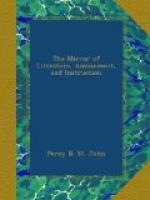That the Caledonians paid a superstitious respect to the sun, as was the practice among many other nations, is evident, not only from the sacrifice of Beltan, but from many other circumstances. When a Highlander goes to bathe, or to drink water out of a consecrated fountain, he must always approach by going round the place from east to west on the south side, in imitation of the apparent diurnal motion of the sun. When the dead are laid in the earth, the grave is approached by going round in the same manner. The bride is conducted to her future spouse in the presence of the minister; and the glass goes round in company in the course of the sun. This is called in Gaelic, going round in the right or lucky way; the opposite course is the wrong or unlucky way.
FHAOLAIN.
* * * * *
ABORIGINES OF VAN DIEMAN’S LAND.
So little is known of these children of nature, and still less has been done to gain any knowledge of them, that not much can be offered as to their present numbers or condition. From what I have seen and read, the natives of Van Dieman’s Land are unlike any other Indians, either in features, their mode of living, hunting, &c. There are many hundreds of people who have lived for years in the colony, and yet have never seen a native. ... The features of these people are any thing but pleasing: a large flat nose, with immense nostrils; lips particularly thick; a wide mouth, with a tolerably good set of teeth; the hair long and woolly, which, as if to confer additional beauty, is besmeared with red clay (similar to our red ochre) and grease. Their limbs are badly proportioned; the women appear to be generally better formed than the men. Their only covering is a few kangaroo skins, rudely stitched, and thrown over the shoulders; but more frequently they appear in a state of nudity; indeed, so little knowledge have they of decency or comfort, that they never avail themselves of the purposes for which apparel is given to them. Lieut. Collins, in his account of the natives of New South Wales, describes their marriage ceremonies




